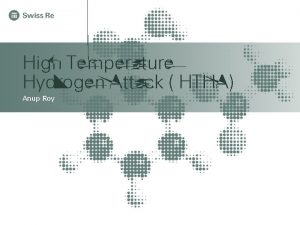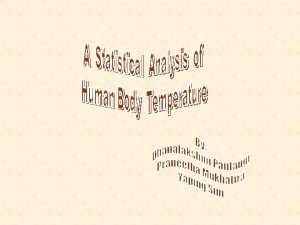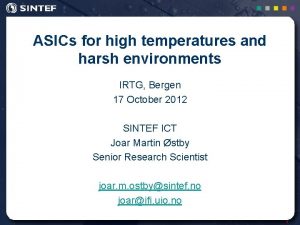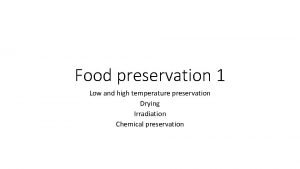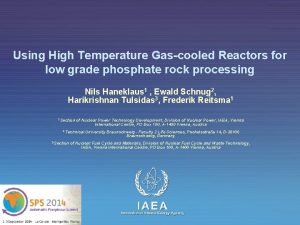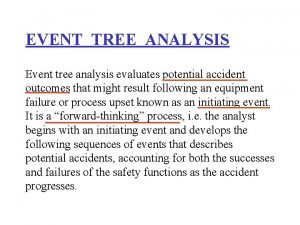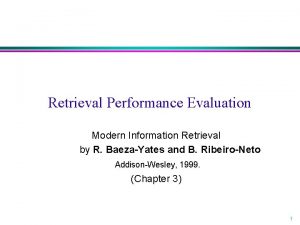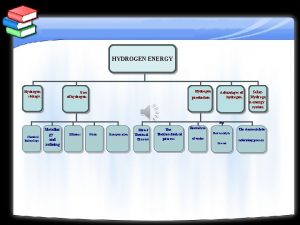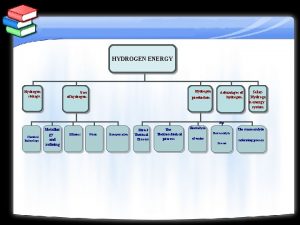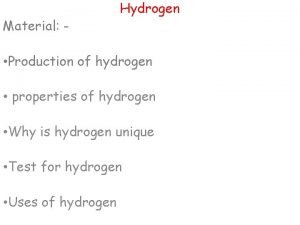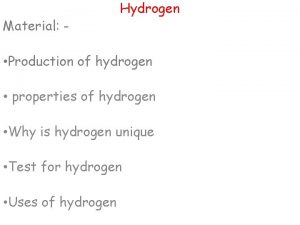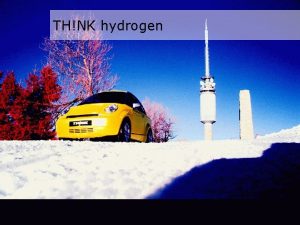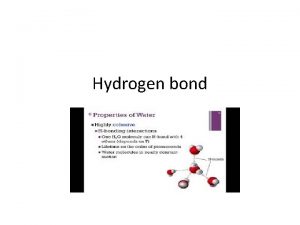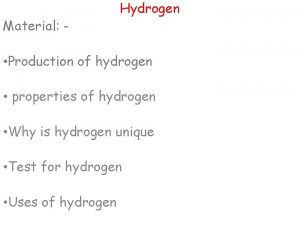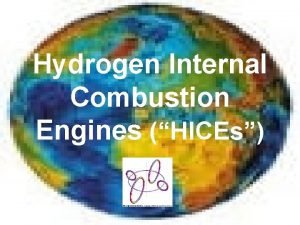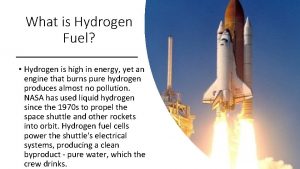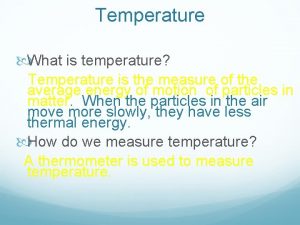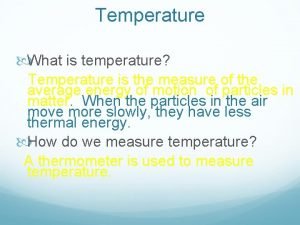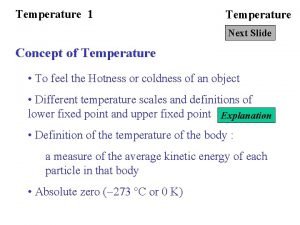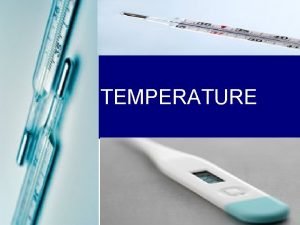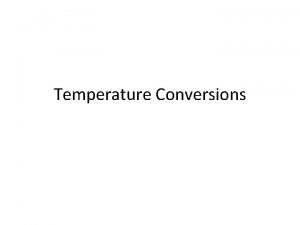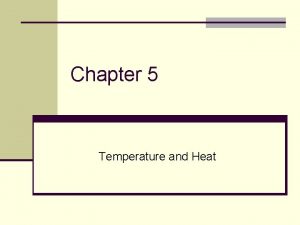High Temperature Hydrogen Attack HTHA Anup Roy Internal































- Slides: 31

High Temperature Hydrogen Attack ( HTHA) Anup Roy

Internal What is High Temperature Hydrogen Attack (HTHA) ? At elevated temperatures, molecular Hydrogen dissociates into the atomic form, which can readily enter and diffuse through steel. This Hydrogen reacts with the Carbides in the steel to form Methane which cannot diffuse through steel. Methane presure builds up to form bubble or cavities, microfissure that may combine to form cracks. Two type of HTHA are Surface decarburization and internal decarburization and fissuring 2

Internal Affected materials • In order of resistance : – Carbon steel ( non PWHT< PWHT) – C-0. 5 Mo – Mn-0. 5 Mo – 1 Cr-0. 5 Mo – 1. 25 Cr-0. 5 Mo – 2. 25 Cr- 1 Mo – 2. 25 Cr-1 Mo-V – 3 Cr-1 Mo – 5 Cr-0. 5 Mo – 300 series SS ( Austenitic) as well as 5 Cr, 9 Cr, 12 Cr alloys are not susceptible 3

Internal Affected units • Hydro-processing units like – Hydrotreater , hydrocrackers, catalytic reformers, hydrogen producing units and hydrogen clean up units like PSA units • Boiler tubes in very high pressure steam service • Several HTHA failures were found in non –PWHTed CS in liquid-filled piping downstream of gasoline desulfurization unit reactors that were operating at hydrogen partial pressures and temperatures below the Figure 1 carbon steel curve. Related Mechanisms as per API RP 571 • A form of HTHA can occur in boiler tubes and is referred to by the fossil utility industry as hydrogen damage. 4

Internal Critical Factors: • Dependant upon – Temperature – Hydrogen partial pressure – Time ( Service exposure time is cumulative) – Stress • HTHA is preceded by a period of time when no noticeable change occurs called the incubation time. Current usual NDE techniques cannot detected it and the mechanical properties are not affected noticeably. This may vary from few hours to many years. 5

Internal 4 stages of HTHA a) The incubation period during which the microscopic damage cannot be detected with advanced NDE techniques and even the mechanical properties doesn’t change. b) The stage where damage is detectable optically ( <1500 X magnification), possibly detectable by advanced NDE techniques and mechanical properties are partially deteriorated. c) the stage of rapid mechanical property deterioration associated with rapid fissure growth d) the final stage where carbon in solid solution is exhausted and mechanical properties reach their final value. 6

Internal 7

8

Internal Nelson Curve 9

Internal Prevention and Mitigation a) Use alloy steels with chromium and molybdenum to increase carbide stability thereby minimizing methane formation. Other are Tungsten and Vanadium. CSB 2014 report emphasised on inherently safer design with reference to API RP 571 to use 5 Cr, 9 Cr, 12 Cr alloys. b) Normal design practice is to use 25°F to 50°F safety factor approach when using API RP 941 curves. Because of uncertainty of the actual operating conditions over many decades of operation for data points contained in the curves, there is an error of ± 20 °F ( ± 11°C). These points are based largely on empirical experiences. c) Several failures of C- 0. 5 Mo have been reported under the curves which were reported safe earlier. The C-0. 5 Mo curve was removed in 1990 edition of API RP 941 and is not recommended for new construction in hot hydrogen service. For existing equipments this concern has prompted an economic review of inspection cost versus replacement with a more suitable alloy. Inspection is difficult as the problems have occurred in Weld HAZ as well as Base metals away from welds. 10

Internal Prevention and Mitigation continued… d. 300 Series ( austenitic) SS overlay and/or roll bond clad material is used in Hydrogen service where base material doesn’t have enough adequate sulfidation resistance. Although it is recognized that properly metallurgically bonded austenitic overlay/clad will decrease the hydrogen partial pressure seen by the underlying metal, most refiners make sure the base metal has adequate resistance to HTHA under service conditions. As per API 941 "It is not advisable to take a credit for the presence of a stainless steel cladding/weld overlay when selecting the base metal for a new vessel. " " Satisfactory performance in such cases requires assurance that the effective hydrogen partial pressure acting on the base metal be accurately determined and that the integrity of the cladding/weld overlay be maintained. Such assurance may be difficult to achieve, especially where complex geometries are involved. Many operators take the presence of an austenitic stainless steel cladding/weld overlay into account when establishing inspection priorities for HTHA, especially for C 0. 5 Mo steel equipment. " 11

Internal Prevention and Mitigation continued… d. For cold-wall refractory lined equipment or piping, there can be risk of HTHA when internal process conditions are above the curves and the refractory lining has degraded causing hot spots. The risk level may be lowered if there are effective techniques of promptly detecting hot spots and efficient means of keeping it cooled. e. Some existing inspection methods attempt to identify HTHA, however, inspection should not be solely relied on to identify and control HTHA. Inspection results can be unreliable and misleading. Successful identification of HTHA is highly dependent on the specific techniques employed and the skill of the inspector, and few inspectors have this level of expertise. The advanced stage of attack is much easier to detect but at that point there is already a higher likelihood of equipment failure ( CSB 2014 report) f. API 971's Nelson curves only talks about HTHA and other comechanisms should be taken into consideration while designing. ex – during Tesoro NHT incident hydrogen-induced cold cracking may have served as the initiation points in HAZ as per NIST report 12

Internal Tesoro Incident from only HTHA perspective https: //www. youtube. com/watch? v=8 v. Pa QYM-t. Ws#t=217 13

Internal 14

Internal Heat criteria was met • B & E heat exchangers lacked instrumentation to monitor shell side inlet temperatures. • Inaccurate understanding of stainless steel cladding ( SS 316) covering the inside surface of the B and E exchangers. Every Damage Mechanism Hazard Review ( DMHR also known as a corrosion review) conducted over the 20 years before April 2010 incident has this assumption. ( disconnect between design and process team) • Actual temperatures were much higher due to fouling of the tubes. • Process excursions occurred in the past but no follow up was done. 15

Internal 16

Internal 17

18

Internal 19

Internal Nelson Curves ( as per latest API 941 draft – not published yet) 20

Internal Nelson Curves • First developed in 1949 by George Nelson • Based on industry experience • After his death none of his original data was found and ONLY THE INFO contained on the actual Nelson Curves on available to API and rest of the industry • On the basis of that document API published RP 941 in 1970 • API TR 941 (Technical basis Report) addresses several possible limitations of the NC. It acknowledges " We are still far from being able to make quantitative predictions about behavior of steel subjected to HTHA" • Critics say that HTHA is too complex to be shown in simplistic Nelson Curves as a function of Material of Construction, temperature and Hydrogen partial pressure. Factors like Stress, Carbide stability, grain size, type of weld and time of operation are also important. • Tesoro NHT incident showed Nelson curves are unreliable. 21

Internal Other failures stories of Nelson Curve • Exxon Mobil Incident – • • Cracking was observed in non PWHT CS constructed in 1970 s operating below NC. CSB learned 8 incidents where HTHA reportedly occurred below the Carbon nelson curve. – Valero reported 3 incidents at the Corpus Christi refinery and one incident at Texas city refinery – Conoco. Phillips ( location not known) – Shell ( location not known) 22

Internal Assumptions in PHA !!! a) Tesoro's PHA team under-estimated the damage and hence it came very low as per the risk matrix. Also assumed in PHA that " The System has a corrosion inspection program. Leaks or loss of containment due to corrosion of pipes and vessels is not credible for pipes and vessels included in these programs. " b) The Tesoro 2007 PSM and RMP compliance audit indicated that previous PHAs at the Tesoro Anacortes Refinery lacked sufficient detail and did not identify all of the hazards of the process. As a result a "redone from scratch" was done for the NHT just 38 days before the incident but still with the ASSUMPTION of corrosion program in place and not reviewing it. - Missed to identify HTHA again !!! "The equipment is inspected per the plant preventive maintenance standards, and maintenance is performed promptly. " " The materials of construction of piping, gaskets, vessels, and valves have been correctly selected according to Shell design standards. " Even Shell oil failed to identify HTHA in this unit in 1996 PHA. 23

Internal API 941 (Steels for Hydrogen Service at Elevated Temperatures and Pressures in Petroleum Refineries and Petrochemical Plants ) Limitations • There are no minimum requirements for users to perform HTHA susceptibility evaluations • There are no requirements for users to select inherently safer materials of construction • There are no minimum requirements for users to verify process operating conditions of equipment that is potentially susceptible to HTHA. API 941 can be applied to ammonia, methanol, edible oil, and higher alcohol plants. 24

Internal API RP 580 Risk Based Inspection / API 581 Risk Based Inspection Technology Limitations • The API RP 581 model represents an early attempt to address the shortcomings of the empirical Nelson curves. • API RP 581 lacks specific direction to ensure that users employ appropriate actual operating conditions. 25

Internal Inspection Techniques • HTHA inspection require special techniques. Methods used for corrosion and wall thinning is not adequate primarily because HTHA is NOT readily evident on surface. • May occur in Welds, weld HAZs or base metal. • Accepted HTHA inspection techniques – Advanced Ultrasonic Backscatter Techniques ( AUBT) – Phased array – In-situ Metallography 26

Internal BONUS SLIDES 27

Internal Cultural issues with the incident a) Belief that it cannot happen here b) Normalization of deviance ( leaks is a part of start up ) - Two more leaks were reported on the night of the incident c) Onus of proof – Requiring proof of danger rather than proof of safety Other factors … a) Maintenance operating procedures were not updated. – only one personnel required as per procedure. b) Regulatory system in need of reform 28

Internal Effect of Heat Treatment • Both high PWHT temperatures and longer times are beneficial. • HTHA resistance of 1 Cr-0. 5 Mo, and 1. 25 Cr-0. 5 Mo steels is improved by raising the minimum PWHT temperature to 1250 °F (677 °C) from the 1100 °F (593 °C) minimum required by past editions of the Section VIII of the ASME Code. • The user must balance the advantages of high PWHT temperatures with other factors, such as the effect upon strength and notch toughness. 29

Internal 30

Internal Legal notice © 2015 Swiss Re. All rights reserved. You are not permitted to create any modifications or derivative works of this presentation or to use it for commercial or other public purposes without the prior written permission of Swiss Re. The information and opinions contained in the presentation are provided as at the date of the presentation and are subject to change without notice. Although the information used was taken from reliable sources, Swiss Re does not accept any responsibility for the accuracy or comprehensiveness of the details given. All liability for the accuracy and completeness thereof or for any damage or loss resulting from the use of the information contained in this presentation is expressly excluded. Under no circumstances shall Swiss Re or its Group companies be liable for any financial or consequential loss relating to this presentation. 31
 Nelson curve htha
Nelson curve htha Dr anoop mishra herbalife
Dr anoop mishra herbalife Anup dutta hcl
Anup dutta hcl Active attack and passive attack
Active attack and passive attack Active attack and passive attack
Active attack and passive attack Roy mathews bainbridge
Roy mathews bainbridge Difference between curie temperature and neel temperature
Difference between curie temperature and neel temperature Difference between curie temperature and neel temperature
Difference between curie temperature and neel temperature Ferrimagnetism
Ferrimagnetism Body temperature introduction
Body temperature introduction High temperature in food preservation
High temperature in food preservation Preservation by high temperature
Preservation by high temperature Daikin altherma flow switch
Daikin altherma flow switch Pcr annealing temperature too high
Pcr annealing temperature too high High temperature asic
High temperature asic Food preservation by high temperature
Food preservation by high temperature High temperature reactor
High temperature reactor High precision temperature controller
High precision temperature controller High temperature shutdown
High temperature shutdown Internal control structure
Internal control structure Audit report of a company
Audit report of a company High precision vs high recall
High precision vs high recall High precision vs high recall
High precision vs high recall Directive behavior and supportive behavior
Directive behavior and supportive behavior High expectations high support
High expectations high support Significant figures
Significant figures Enthusiastic beginner disillusioned learner
Enthusiastic beginner disillusioned learner Investasi adalah
Investasi adalah Romit roy choudhury
Romit roy choudhury Roy kenshin lee
Roy kenshin lee Hot zulu girl
Hot zulu girl Hubbart formula
Hubbart formula
